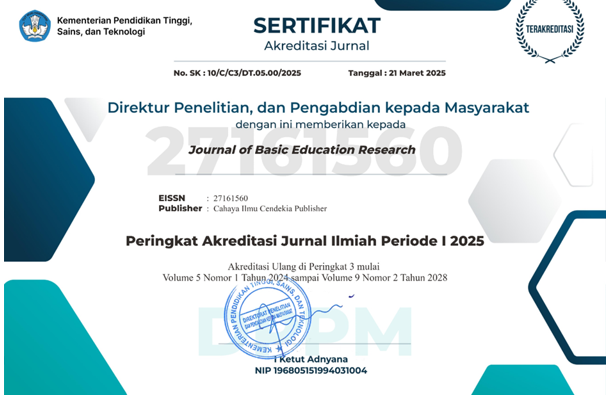Improving Students' Ability to Solve Space Building Problems Through the Bamboo Dancing Learning Model in Elementary School
Abstract
Purpose of the study: This study aimed to investigate the effectiveness of the bamboo dancing learning model in enhancing students' problem-solving skills related to spatial geometry.
Methodology: Conducted as Classroom Action Research (CAR), the study was implemented in two cycles, each consisting of four stages: planning, action, observation, and reflection. Data collection methods included observation, tests, and documentation. The subjects were 24 students from VD class at SDN No.13/1 Muara Bulian, comprising 12 female and 12 male students.
Main Findings: The study found that the bamboo dancing learning model significantly improved students' problem-solving abilities in spatial geometry. This model involved students working on problems through discussions with partners, followed by a rotation to new partners, mimicking the movements of bamboo dancing. Varied learning media were used in each cycle to enhance the learning process. In the first cycle, the success rate of students' problem-solving abilities was 61.01%, categorized as sufficient. By the second cycle, the success rate increased to 81.64%, categorized as good. These results indicate that the bamboo dancing learning model met the research achievement indicators, demonstrating its effectiveness in improving students' spatial problem-solving skills.
Novelty/Originality of this study: This research is innovative as it combines spatial mathematics with the performing art of bamboo dancing. This interdisciplinary approach not only enhances students' geometric problem-solving skills but also enriches their learning experiences by integrating physical movement and cultural elements. By visualizing and physically practicing spatial concepts through bamboo dancing, students internalize the material more effectively.
References
A. S. Munna and M. A. Kalam, “Teaching and learning process to enhance teaching effectiveness: a literature review”, International Journal of Humanities and Innovation (IJHI), vol. 4, no. 1, pp. 1-4, 2021.
K. Kamid, M. Mujahidawati, D. Iriani, and A. M. Nawahdani, “Scientific Learning and Process Skills Mathematics: Comparison and Relationship”, JPI (Jurnal Pendidikan Indonesia), vol. 12, no. 2, pp. 228-239, 2022.
R. Rafiola, P. Setyosari, C. Radjah, and M. Ramli, “The effect of learning motivation, self-efficacy, and blended learning on students’ achievement in the industrial revolution 4.0”, International Journal of Emerging Technologies in Learning (iJET), vol. 15, no. 8, pp. 71-82, 2020.
T. I. B. Al-Tabany, “Mendesain Model Pembelajaran Inovatif, Progresif, dan Kontekstual”, Jakarta: Kencana, 2014.
D. Olivares, J. L. Lupiáñez, and I. Segovia, “Roles and characteristics of problem solving in the mathematics curriculum: a review”, International Journal of Mathematical Education in Science and Technology, vol. 52, No. 7, pp. 1079-1096, 2021.
F. Ukobizaba, G. Nizeyimana, and A. Mukuka, “Assessment Strategies for Enhancing Students' Mathematical Problem-Solving Skills: A Review of Literature”, Eurasia Journal of Mathematics, Science and Technology Education, vol. 17, no. 3, 2021.
K. Kamid, D. A, Kurniawan, and A. M. Nawahdani, “Scientific Learning Model: Analytical Thinking and Process Skills in Mathematics”, Journal of Education Research and Evaluation, vol. 6, no. 3, pp. 538-549, 2022.
S. R. Andini, V. M. Putri, M. Y. Devi, and Y. Erita, “Mendesain Pembelajaran PKn dan IPS yang Inovatif dan Kreatif dengan Menggunakan Model Pembelajaran Pada Tingkat Sekolah Dasar”, Jurnal Basicedu, vol. 5, no. 6, pp. 5671-5681, 2021.
A. M. Nawahdani, D. A. Kurniawan, and D. Melisa, “Analisis Model Project Based Learning Terhadap Keterampilan Proses Sains Peserta Didik Pada Mata Pelajaran Fisika”, In Prosiding Seminar Nasional Matematika Dan Sains pp. 348-354, 2021.
S. L. Dewi, “Pengaruh metode mengajar terhadap minat belajar siswa sekolah dasar pada pelajaran matematika”, JPMI (Jurnal Pembelajaran Matematika Inovatif), vol. 4, no. 4, pp. 755-764, 2021.
Z. Zuraida, “Pembelajaran Bamboo Dancing Salah Satu Model Cooperative Learning Untuk Meningkatkan Proses Pembelajaran Di Sekolah Dasar”, Vol XV (1), 2015.
A. Al Azmi, M. Muchtar, and A. Fuadi, “Penerapan Model Pembelajaran Bambo Dancing Terhadap Hasil Belajar Siswa Pada Mata Pelajaran Akidah Akhlak Siswa Kelas VIII Di MTS N 1 Langkat”, Jurnal Pusat Studi Pendidikan Rakyat, pp. 135-148, 2023.
N. Setyobudi, A. R. Umah, D. S. Sapitri, and E. Hidayatin, “Implementation of the Bamboo Dancing Learning Model to Enhance Learning Outcomes of Grade V Students in Akidah Akhlak Subject at MI Nurussalam Ngawi”, Al-Lubab: Jurnal Penelitian Pendidikan dan Keagamaan Islam, vol. 9, no. 2, pp. 68-80, 2023.
Latifah, et. al., “Penerapan Model Pembelajaran Bamboo dancing Dalam Pembelajaran Keliling Dan Luas Segiempat Dan Segitiga Untuk Meningkatkan Keterampilan 4C Siswa SMP Kelas VII”, 978-979-3812-46-5, 2016.
S. Sugiyono, Metode Penelitian Pendidikan, Bandung: Alfabeta, 2015.
K. Kunandar, Penelitian Tindakan Kelas, Jakarta: Rajawali Pers, 2010.
S. Sugiyono, Metode Penelitian Pendidikan, Bandung: Alfabeta, 2013.
S. Arikunto, Prosedur Penelitian, Jakarta: Rineka Cipta, 2013.
S. Harmini and G. Roebyanto, Pemecahan Masalah Matematika, Bandung: PT Remaja Rosdakarya, 2017.
A. Susanto, Teori Belajar & Pembelajaran di Sekolah Dasar, Jakarta: Kencana Prenada Media Group, 2013.
A. Suprijono, Cooperative Learning, Yogyakarta: Pustaka Pelajar, 2016.
Copyright (c) 2024 Fernita Setia Ananda

This work is licensed under a Creative Commons Attribution 4.0 International License.
Authors who publish with this journal agree to the following terms:
- Authors retain copyright and acknowledge that the Journal of Basic Education Research is the first publisher licensed under a Creative Commons Attribution 4.0 International License.
- Authors are able to enter into separate, additional contractual arrangements for the non-exclusive distribution of the journal's published version of the work (e.g., post it to an institutional repository or publish it in a book), with an acknowledgment of its initial publication in this journal.
- Authors are permitted and encouraged to post their work online (e.g., in institutional repositories or on their website) prior to and during the submission process, as it can lead to productive exchanges and earlier and greater citation of published work.





.png)


.png)
.png)


















